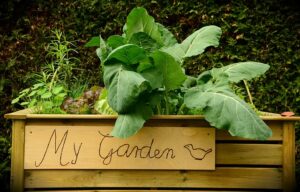
How to Build a Raised Bed Garden: A Step-by-Step Guide
Raised bed gardens have grown in popularity in recent years, and it’s easy to see why. They offer an ideal solution for hobby gardeners who want to grow their plants, even in smaller gardens or on balconies. Raised beds allow for ergonomic work heights, promote plant growth through better soil conditions, and provide protection against slugs and other pests. But how do you go about building a raised bed garden? In this blog post, we’ll walk you through the process step-by-step, outline the materials you’ll need, and highlight key considerations to keep in mind.
Why Build a Raised Bed?
Before diving into the how, let’s first consider why you might want to build a raised bed:
- Ergonomic Working Height: No more bending over! The elevated position of the bed makes gardening easier and reduces back strain.
- Improved Soil Conditions: The layering of a raised bed provides loose, well-aerated soil, which promotes plant growth.
- Heat Insulation: The decomposition of the lower layers generates heat, speeding up plant growth.
- Pest Protection: Slugs and other pests have a harder time reaching raised beds.
- Versatility: Raised beds can be placed almost anywhere—garden, terrace, or even balcony.
Planning and Preparation
Location: Choose a sunny spot, ideally with at least six hours of sunlight per day. The location should be easily accessible and provide enough space for maintenance.
Size: The size of the raised bed depends on your available space and needs. Typically, raised beds are about 1 to 1.2 meters wide (so you can comfortably work from both sides), 2 to 3 meters long, and around 80 cm high.
Material: Wood is the most commonly used material for raised beds because it looks natural and is easy to work with. Larch wood is especially resistant to weather conditions. Alternatively, you can use metal, stone, or plastic.
Materials List
- Wooden planks or boards (e.g., larch wood)
- Corner posts or metal brackets for stability
- Screws and nails
- Weed barrier fabric or garden fleece
- Wire mesh (optional, for protection against burrowing animals)
- Cordless drill
- Saw
- Measuring tape
- Level
- Hammer
Construction Guide
Start by building the frame. Cut the wooden planks to the desired length. The height of the raised bed should be at least 60 cm to allow enough space for the different layers. Attach the planks at the corners using corner posts or metal brackets. Use screws and a cordless drill to ensure a sturdy construction. Make sure the frame is square, checking with a level.
Step 2: Preparing the Ground
Prepare the ground by removing any weeds and loosening the soil slightly. If you’re placing the raised bed on grass or soil, consider laying down a wire mesh to protect against burrowing animals. Next, lay down a weed barrier fabric or garden fleece to prevent weeds from growing into the raised bed while still allowing water to drain.
Step 3: Layering the Bed
A raised bed consists of several layers, each serving different purposes. Here is a typical layering from bottom to top:
First Layer (20-30 cm): Coarse tree and shrub cuttings, twigs, or branches. This layer ensures good drainage and aeration.
Second Layer (10-20 cm): Coarse compost or semi-decomposed leaves. This layer provides nutrients and encourages decomposition.
Third Layer (10-20 cm): Finer materials such as garden waste, grass clippings, or finely chopped branches. This layer acts as a buffer.
Fourth Layer (20-30 cm): High-quality, mature compost or topsoil. This is the top layer and serves as the planting substrate.
Step 4: Planting
After setting up the layers, you can immediately start planting your raised bed. Choose plants that work well together and have similar soil and light requirements. Lettuce, herbs, tomatoes, zucchini, and peppers are popular choices for raised beds. Make sure to plant taller crops in the center or at the back to avoid shading shorter plants.
Step 5: Maintenance of the Raised Bed
Maintaining a raised bed is relatively straightforward but does require regular attention:
Watering: Raised beds tend to dry out faster than traditional garden beds. Water regularly, especially during hot days. Drip irrigation can be very helpful here.
Fertilizing: Since nutrients are continuously released through the decomposition process, additional fertilization is often not necessary. However, you can add a layer of compost in spring to refresh the nutrients.
Weed Control: Thanks to the layering and weed barrier, weeds are rarely a problem in raised beds. Still, remove any unwanted plants regularly.
Refilling Soil: Over time, the soil in the raised bed will settle. Each spring, add fresh topsoil or compost to replenish the raised bed and renew nutrients.
Tips and Tricks
Companion Planting: Plant your raised bed with a variety of plants that benefit each other. For example, tomatoes and basil grow well together as basil can repel pests.
Crop Rotation: Rotate the types of crops each year to avoid depleting the soil and prevent pest infestations.
Weather Protection: If you live in an area with heavy rainfall, consider covering the raised bed with a small roof. This keeps the soil loose and prevents it from being washed away.
Winter Preparation: After harvesting, cover the raised bed with leaves, straw, or a mulch layer. This protects the soil from erosion and frost while enriching it with nutrients.
Conclusion
A raised bed is a fantastic way to garden successfully, even in limited space. It’s not only functional and practical but can also be an aesthetic highlight in your garden or on your terrace. With proper planning, the right materials, and a bit of DIY skill, you can build a raised bed that will bring joy and a bountiful harvest for many years. Whether you’re an experienced gardener or just starting, a raised bed is a worthwhile investment in your gardening future.


